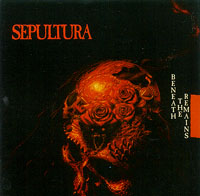Sepultura - Beneath the Remains
Review: Combining the bolt-ahead and blast tendency of technical death metal with the stylings of speed metal bands who hammered their riffs home to a concluding micro-phrase, Sepultura have rendered from chaos a masterpiece of controlled energy defining its outlets before unleashing the pulse of destructive energy which converts them humanity's self-destructive inner anger into a directive of vivid existence. This album takes class from Slayer on song structures, with most choruses and every other verse having an introductory changeover of instrumental significance to transfer the abundant energy of its vibrant resiliency back into the churning main riff rhythm and structural silhouette (a technique borrowed from thrash: to use the riff to define the song, taken to abstract levels by death metal bands who invented the riff-concept behind the riff and used it in the style of classical music to fuse songs from scrapyards of fragmentary structure). It is neck-breaking excitement that also stirs the soul with its excitement to live.
Sepultura combine textures as part of the fundamental philosophy of the band, pairing the note-hopping melodic ascent of a heavy metal phrase with a cluster of fast thrashed chords charged by a dissonant note harmonic loop providing both context and concrete coherence to the otherwise panoramic expansion of riffs from one or two power chord microstructures which define a direction and its essential return in a recursive yet open structure. In a meta-mimicry of the textural shifts within riffs, songs as a whole reveal their layers in the differing structures which define their parts and the similarities between them through the detail-oriented world of embedded melody, where the winging electric strum of the rhythm guitar aligns the current pattern into the overall composition by means of the metaphor in related archetypal granularity. Each part defines the whole, which in turn defines the relevance of each part: a metaphor for existence in a chaotic but ordered world.
Excellent percussion, throwing progressive beats within the alternately driving and extended-expectancy phrase-filling patterns, provides only one of the motifs which make these songs as distinctive as they are powerful. Structural riff-centric composition and unique structural vocabulary make each song stand out as demonstratively from an introductory beginning to the staggered levels of revelatory breakdown that lead each tune to peak intensity and culmination; vocal patterns, in the cadenced industrial-tribal shout which is half hoarse-vocal and half thrash rant, mold engagingly to the more complex holdback rhythms the drums have to offer, installing another measure of both singularity and energetic potency in each song. An accent of quirky and humorous but analytical lead guitar weaves through both the hauntingly unresolved dissonance that trademarks the epic aspect of this album and the solidly resounding harmonic centering with alacritous discharge of its own expectation and furious inventive anarchism.
Built from an abundance of creative riffing and expert song formation, "Beneath the Remains" is a classic that integrates two genres at the time when their ideologies fused to contribute the next step in metal's evolution to the genre. For this intensity and individualism this album rewarded its creators and listeners alike with a testament to the metallic spirit that does not age with time but holds forth its celebrative fusion of angst and joy of life for all ages to learn from.
